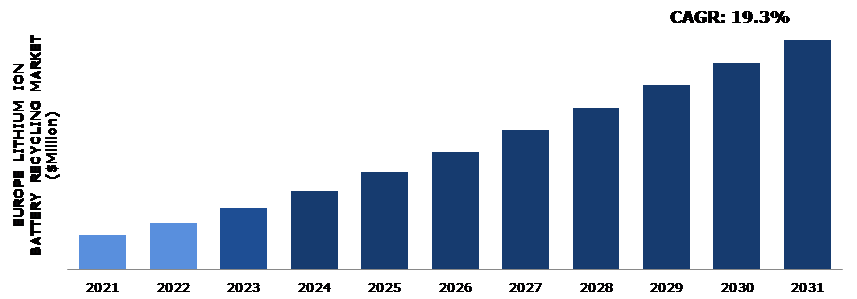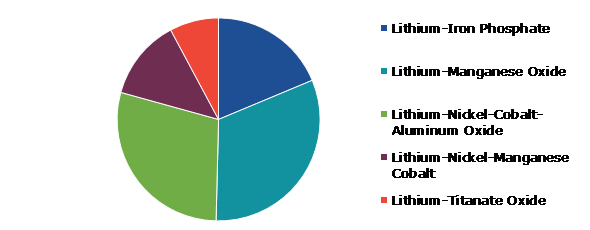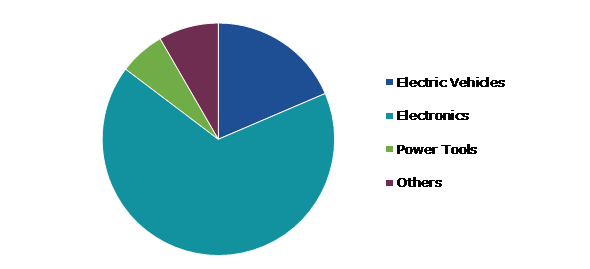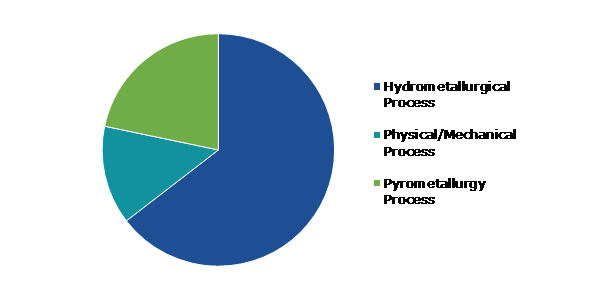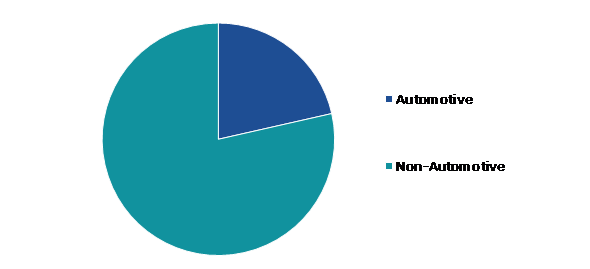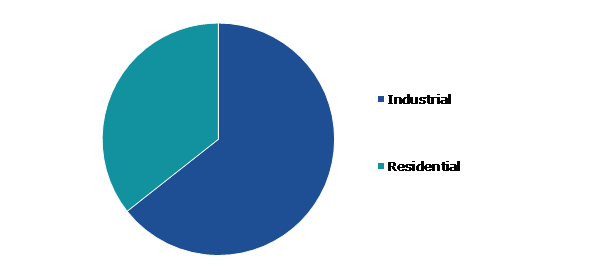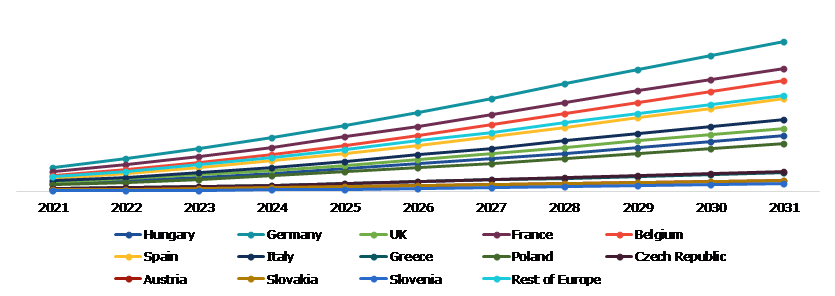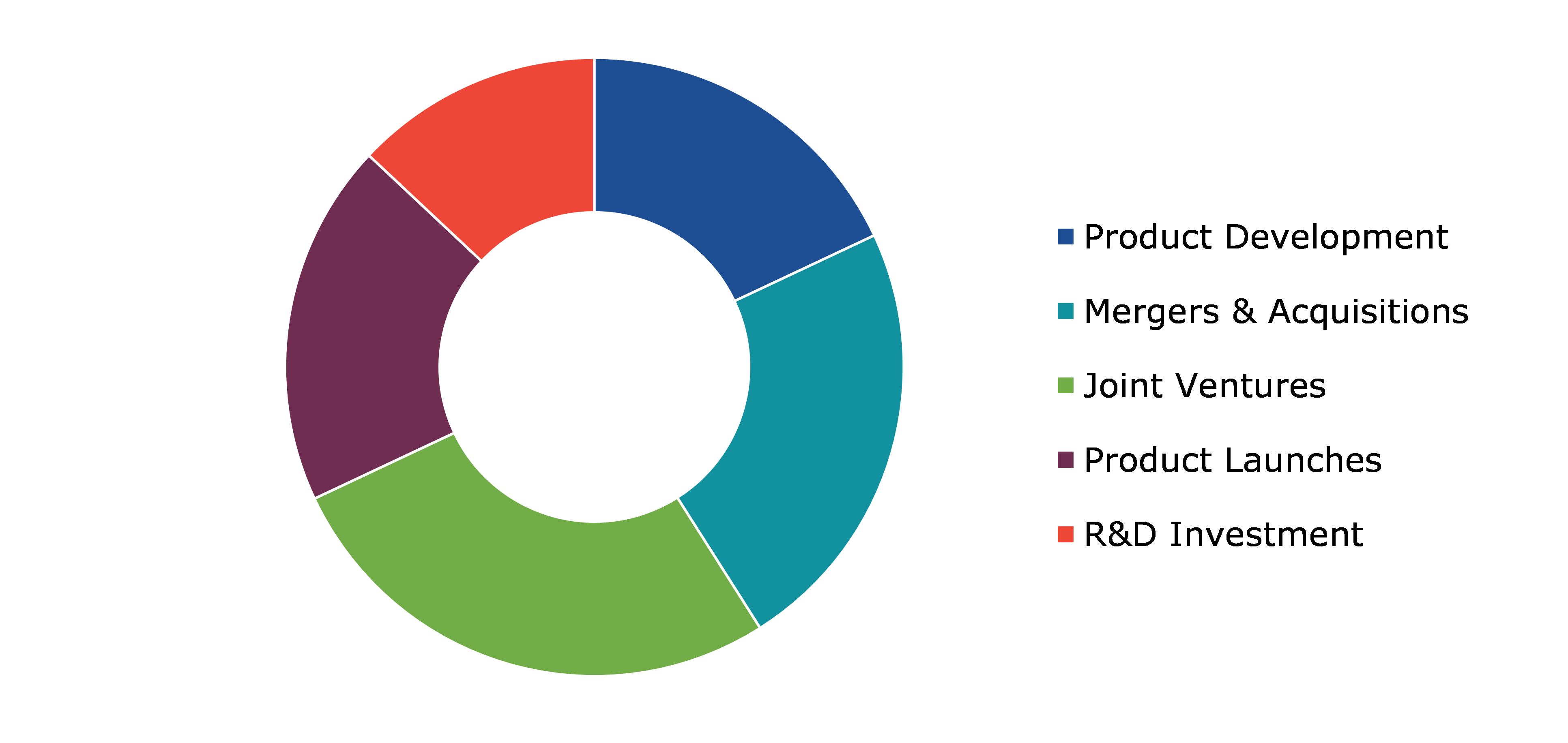Europe Lithium-ion Battery Recycling Market Report
RA08649
Europe Lithium-ion Battery Recycling Market by Battery Chemistry (Lithium-Iron Phosphate, Lithium-Manganese Oxide, Lithium-Nickel-Cobalt-Aluminum Oxide, Lithium-Nickel-Manganese Cobalt, and Lithium-Titanate Oxide), Source (Electric Vehicles, Electronics, Power Tools, and Others), Recycling Process (Hydrometallurgical Process, Physical/Mechanical Process, and Pyrometallurgy Process), End-user (Automotive and Non-automotive), Application (Industrial and Residential), and Country Analysis (Hungary, Germany, UK, France, Belgium, Spain, Italy, Greece, Poland, Czech Republic, Austria, Slovakia, Slovenia, and Rest of Europe): Opportunity Analysis and Industry Forecast, 2022-2031
Europe Lithium-ion Battery Recycling Market Analysis
The Europe Lithium-ion Battery Recycling Market Size was $456.20 million in 2021 and is predicted to grow with a CAGR of 19.3%, by generating a revenue of $3,015.50 million by 2031.
Europe Lithium-ion Battery Recycling Market Synopsis
Lithium-ion batteries are rechargeable batteries that use lithium metal oxides as positive electrodes to store lithium ions. Also, the usage of lithium-ion batteries in electric cars has propelled the Europe lithium-ion battery industry and, as a result, the constituent materials recycling demand is increasing throughout Europe. The European Union has set ambitious targets for reducing greenhouse gas emissions and increasing the use of renewable energy sources. The recycling of lithium-ion batteries is an essential part of achieving these goals, as it reduces the environmental impact of battery production and disposal. The Europe lithium-ion battery recycling market is being driven by government regulations and policies that promote sustainable waste management practices. The EU has set targets for the recycling of batteries, and member states have implemented regulations to ensure that lithium-ion batteries are properly disposed of and recycled. Moreover, the increasing adoption of electric vehicles in Europe is also driving the growth of the Europe lithium-ion battery recycling market.
A lack of knowledge on the chemistry of Li-ion batteries hinders the battery recycling process and may result in technical mishaps. Many consumers may not be aware of the importance of recycling lithium-ion batteries, which could limit the supply of batteries available for recycling. Improving consumer education and awareness could help address this issue. The lack of consumer awareness about the importance of recycling lithium-ion batteries can be a significant barrier to the growth of the European lithium-ion battery recycling market,
The market for recycling Li-ion batteries is currently very active. In order to assure the supply of raw materials, numerous new relationships have been established along the supply chain from raw material mining firms to system integrators. For instance, partnerships between system integrators and recyclers such as Audi and Umicore makers and battery recyclers can help ensure the availability of raw materials for both parties.
According to country analysis, the Germany lithium-ion battery recycling market accounted for highest market share in 2021. Germany's high demand for electric vehicles, with various governments offering subsidies for rechargeable batteries is one of the main drivers for the lithium-ion recycling industry.
Europe Lithium-ion Battery Recycling Overview
Europe lithium-ion batteries are widely used in many applications, including electric vehicles, portable electronics, and renewable energy storage. However, these batteries also create environmental challenges due to their hazardous components and limited lifespan. The European Union has developed policies and regulations to promote the recycling and circular economy of lithium-ion batteries. The EU has set targets for collecting and recycling batteries, as well as reducing the use of hazardous materials in battery manufacturing. Similarly, electronic and electrical equipment, as well as lithium-ion batteries, have been abandoned at the end of their life cycles.
COVID-19 Impact on Europe Lithium-ion Battery Recycling Market
The Europe coronavirus pandemic has had a profound impact on the lives of many people in nearly every country. The energy materials and battery manufacturing industry including grid storage, personal electronic devices, and battery-powered electric vehicles felt the effect of the pandemic. Also, the battery recycling industry across the globe has witnessed a negative impact during the pandemic. The COVID-19 pandemic struck, putting lives in danger, disrupting supply chains and workforces, and shutting down factories.
The economic slowdown impacted the auto industry, resulting in sharp drops in electric vehicle sales. This has had a long-term effect on the battery recycling business as governments redirected funding to the development of essential medical infrastructure to address the rise of COVID-19 cases in Europe. In addition, the material flow into and out of China, the biggest center for recycling and battery manufacturing, was hampered by travel and import-export restrictions. As a result, interruptions in the battery recycling and supply chain have had a significant impact on non-renewable and toxic materials like lead, cobalt, and lithium. The market share for battery recycling has been significantly impacted by these factors during the COVID-19 pandemic. The COVID-19 pandemic has caused delays in a variety of businesses. To reduce transmission, government agencies are introducing new regulations like lockout and social isolation. A halt in cross-border commerce would have a severe impact on the supply chain network. To help our clients better comprehend the present situation, we provide in-depth insights into the lithium-ion battery recycling sector.
Increasing Support by European Union (Eu) for Lithium-ion Battery Recycling to Drive the Market Growth
Lithium-ion batteries are rechargeable batteries that include lithium metal oxides as positive electrodes where lithium ions can be stored. These batteries are mostly utilized in residential applications. However, the use of lithium-ion batteries in electric vehicles has expanded the lithium-ion battery market growth worldwide, and as a consequence, their constituent materials. Comparatively, a less percentage of overall used lithium-ion batteries are recycled today and most end up in landfills. This electronic waste (E-waste) causes severe environmental issues such as water pollution and air pollution. Due to these problems, lithium-ion battery recycling is crucial for governments for a climate-neutral economy. Lithium-ion battery recycling aids in recovering expensive materials such as nickel and cobalt. Their costs have fluctuated in recent years. Recycling lithium-ion batteries would aid in decreasing the dependence on these materials, enhance the battery supply chain security, and lessen the negative environmental and human impact caused by these batteries. On account of these benefits, the European Union (EU) is increasingly focusing on more sustainable battery recycling which is helping the growth of the market.
To know more about Europe lithium-ion battery recycling market drivers, get in touch with our analysts here.
Lack of Collection Infrastructure and Dearth of Technology to Restrain Market Growth
Despite the promising market potential of Europe lithium-ion battery recycling, some major challenges may hamper the market growth. The supply of used li-ion batteries is highly unstandardized and scattered due to various types and sizes of batteries such as li-ion, lead-acid, and others that are collected by independent collectors and recycler companies. This causes a complex and labor-intensive disassembly of batteries before they can be recycled. The transportation of used batteries across Europe is a very expensive process owing to the stringent security regulations including dangerous goods regulations (ADR) and the fewer li-ion battery recycling plants across Europe. In addition, a lack of understanding about the composition of Li-ion batteries among waste collectors is a hindrance to the battery recycling process and can cause technical accidents.
The Growing Use of Recycled Batteries to Drive Excellent Opportunities in the Market
There is a growing need for sustainable recycling of batteries used in consumer electronic applications. Due to a lack of awareness among consumers, used batteries often go in household garbage. Li-ion batteries contain valuable minerals such as nickel, cobalt, graphite, and lithium. These minerals are economically and strategically important to Europe as there is no alternative to these minerals and their supply is susceptible to disruption. The growing popularity of EVs is expected to increase demand for lithium-ion batteries during the forecast period. Supply chain disruptions will result from this, especially when it comes to raw and refined battery materials. Thus, increased attention must be paid to closed-loop battery recycling for the mitigation of supply chain disruption. In addition, if the electronic device that contains a li-ion battery is disposed of in a recycling bin with other recyclables including paper, glass, or plastic, it may create a fire hazard. Concerns are being raised by activists, local governments, and safety professionals about the risks associated with improper lithium-ion battery disposal. Hence, the market offers excellent opportunities to address the concerns.
To know more about Europe lithium-ion battery recycling market opportunities, get in touch with our analysts here.
Europe Lithium-ion Battery Recycling Market, by Battery Chemistry
Based on battery chemistry, the market has been divided into lithium-iron phosphate, lithium-manganese oxide, lithium-nickel-cobalt-aluminum oxide, lithium-nickel-manganese cobalt, and lithium-titanate oxide. Among these, the lithium-manganese oxide sub-segment accounted for the highest market share in 2021 whereas the lithium-iron phosphate sub-segment is estimated to show the fastest growth during the forecast period.
Europe Lithium-ion Battery Recycling Market Size, by Battery Chemistry, 2021
Source: Research Dive Analysis
The lithium manganese oxide sub-segment accounted for a highest market share in 2021. Lithium manganese oxides are actively being sought after for use as lithium-ion battery cathodes. Because of their inexpensive cost and lack of toxicity, manganese-based oxides are typically preferred over cobalt and nickel oxides. Among the most promising materials are layered lithium manganese oxides and spinel lithium manganate. A common application for lithium manganese dioxide cells is to provide memory or microcontroller backup power in the case of a power outage or rechargeable battery depletion.
The lithium-iron phosphate sub-segment is anticipated to show the fastest growth by 2031. A lithium-iron phosphate battery has a cathode made of lithium-iron phosphate (LiFePO4) and an anode composed of graphitic carbon with a metallic backing. When compared to other types of battery materials, lithium-iron phosphate batteries have various benefits, including less weight technology, quick charging, longer cycle life, and low energy wastage, which is propelling the lithium-iron phosphate batteries market. The fundamental factor driving demand for lithium-iron phosphate batteries throughout the forecast period is the rising demand from the automotive sector, particularly electric vehicles, and novel developments in lightweight materials.
Europe Lithium-ion Battery Recycling Market, by Source
Based on source, the market has been divided into electric vehicles, electronics, power tools, and others. Among these, the electronics sub-segment accounted for the highest market share in 2021 whereas the electric vehicles sub-segment is estimated to show the fastest growth during the forecast period.
Europe Lithium-ion Battery Recycling Market Share, by Source, 2021
Source: Research Dive Analysis
The electric vehicles sub-segment is anticipated to show the fastest growth by 2031. The use of renewable biofuels is becoming more prevalent in the automotive industry. The transportation network is significantly reliant on oil as a resource, which raises concerns among economists and environmentalists equally. Electric vehicle adoption is increasing in concert with environmental sustainability. For instance, electric vehicles (EVs) are becoming increasingly popular, which raises the need for fuel cells, which are required for a continuous energy source. The EV sector is expected to grow as a consequence of factors like fuel efficiency, lower emissions, and customer preference. The electric vehicle industry is growing as battery technology progresses and this fuels growth of the Europe lithium-ion battery recycling market.
Europe Lithium-ion Battery Recycling Market, by Recycling Process
Based on recycling process, the market has been divided into hydrometallurgical process, physical/mechanical process, and pyrometallurgy process. Among these, the hydrometallurgical process sub-segment accounted for highest revenue share in 2021.
Europe Lithium-ion Battery Recycling Market Forecast, by Recycling Process, 2021
Source: Research Dive Analysis
The hydrometallurgical process sub-segment accounted for the highest market share in 2021. Hydrometallurgy is considered to be a more environmentally and health-friendly technique than pyrometallurgy. It enables for more element recovery with a better purity grade, less energy usage, and no air emissions. Thermal pre-treatment, on the other hand, aids in the separation of battery components, simplifies the discharging process, and may also be used to remove carbon and organic compounds and dissolve PVDF binder, although requiring gas treatment.
Europe Lithium-ion Battery Recycling Market, by End-user
Based on end-user, the market has been divided into automotive and non-automotive. Among these, the non-automotive sub segment accounted for the highest market share in 2021 and the automotive sub-segment is anticipated to show the fastest growth by 2031.
Europe Lithium-ion Battery Recycling Market Growth, by End-user, 2021
Source: Research Dive Analysis
The non-automotive sub-segment accounted for a highest market share in 2021. Due to their promise to lower greenhouse gas emissions and reduce reliance on oil, electric vehicles are becoming popular. Hybrid-electric, plug-in hybrid, and all-electric cars are anticipated to account for more than half of new car sales. Lithium-ion batteries will be the key to this significant transformation for the vehicle industry. Currently, 96% of all hybrids on the market use nickel metal hydride batteries, but within a few years, it is anticipated that hybrids, plug-in hybrids, and all-electric vehicles will use lithium-ion batteries.
The automotive sub-segment is anticipated to show the fastest growth by 2031. The lithium-ion battery is currently the preferred choice for electric car makers due to its high energy density, low self-discharge rate, and wide range of battery variations available on the market. As a result, lithium prices have been steadily growing in recent years, alongside industrial output, and mineral exploration. In contrast, the average price of batteries has been declining, lowering the cost of electric vehicles and prompting the automotive market. The automotive industry is about to undergo a profound change as a result of the electric vehicle revolution, which is being driven by the necessity to decarbonize personal transportation in order to meet global targets for reductions in greenhouse gas emissions and improve air quality in urban centers.
Europe Lithium-ion Battery Recycling Market, by Application
Based on application, the market has been divided into industrial and residential. Among these, the industrial sub-segment accounted for highest revenue share in 2021.
Europe Lithium-ion Battery Recycling Market Analysis, by Application, 2021
Source: Research Dive Analysis
The industrial sub-segment accounted for the highest market share in 2021. The usage of lithium-ion batteries in industrial applications is motivated by their high energy density, lightweight, increased performance, and long-life cycle. Lithium-ion batteries, both current and in development may enable the initial commercial introduction of eVTOL aircraft; however, considerable breakthroughs in lithium-ion battery technologies will be necessary for the commercial electric aircraft market to be expanded to various classes of aircraft, including large regional and single-aisle 737-class aircraft. Aviation applications may be among the first to embrace next-generation high-specific energy battery technologies, which may not yet fulfill the calendar life and durability criteria of automotive applications.
Europe Lithium-ion Battery Recycling Market, Country Insights
The lithium-ion battery recycling market was investigated across Hungary, Germany, UK, France, Belgium, Spain, Italy, Greece, Poland, Czech Republic, Austria, Slovakia, Slovenia, and Rest of Europe
Europe Lithium-ion Battery Recycling Market Size & Forecast, by Country, 2021-2031 (USD Million)
Source: Research Dive Analysis
The Germany Lithium-ion Battery Recycling Market in Europe was the Most Dominant in 2021
The Germany lithium-ion battery recycling market accounted for the largest market share in 2021. Germany's high demand for electric vehicles, with various governments offering subsidies for rechargeable batteries is one of the main factors driving the lithium-ion recycling industry. Concerns about the environmental impact of automobiles powered by traditional energy sources such as gasoline and diesel have resulted in a significant increase in electric vehicle demand in Germany. Lithium-ion batteries have a wide range of applications, and more advanced characteristics are being developed as more effort is put in through research and development. German companies are also constructing new manufacturing facilities to meet the increasing demand for lithium-ion batteries in applications such as electric vehicles, medical devices, and data communication. New facilities and expanding research and developments are creating new opportunities for the Germany lithium-ion battery recycling market to grow.
Competitive Scenario in the Europe Lithium-Ion Battery Recycling Market
Investment and agreement are common strategies followed by major market players. For instance, The European Battery Alliance (EBA) was established in 2017 by the European Commission, EU countries, industry players, and the scientific community. This alliance includes around 700 members from the batteries industry. The goal of this alliance is to develop a competitive European battery industry. In 2020, ECO2LIB, an EU-funded project was launched. The objective of this project is to produce and recycle ecologically and economically feasible lithium-ion batteries.
Source: Research Dive Analysis
Some of the leading Europe lithium-ion battery recycling market players are Accurec Recycling GmbH, Umicore, Volkswagen Group, BASF SE, REDUX Recycling GmbH, Li-Cycle, Saft Groupe SA, SNAM, Stena Recycling, Eramet.
| Aspect | Particulars |
| Historical Market Estimations | 2020 |
| Base Year for Market Estimation | 2021 |
| Forecast Timeline for Market Projection | 2022-2031 |
| Geographical Scope | Hungary, Germany, UK, France, Belgium, Spain, Italy, Greece, Poland, Czech Republic, Austria, Slovakia, Slovenia, Rest of Europe |
| Segmentation by Battery Chemistry |
|
| Segmentation By Source |
|
| Segmentation By Recycling Process |
|
| Segmentation By End-user |
|
| Segmentation By Application |
|
| Key Companies Profiled |
|
Q1. What is the size of the Europe lithium-ion battery recycling market?
A. The size of the Europe lithium-ion battery recycling market was over $456.20 million in 2021 and is projected to reach $3,015.50 million by 2031.
Q2. Which are the major companies in the Europe lithium-ion battery recycling market?
A. Accurec Recycling GmbH, Umicore and BASF SE are some of the key players in the Europe lithium-ion battery recycling market.
Q3. Which country, among others, possesses greater investment opportunities in the near future?
A. Germany possesses great investment opportunities for investors to witness the most promising growth in the future.
Q4. What will be the growth rate of the Germany lithium-ion battery recycling market?
A. Germany lithium-ion battery recycling market is anticipated to grow at 18.4% CAGR during the forecast period.
Q5. What are the strategies opted by the leading players in this market?
A. Agreement and investment are the two key strategies opted by the operating companies in this market.
Q6. Which companies are investing more in R&D practices?
A. Accurec Recycling GmbH, Umicore, Volkswagen Group, BASF SE, and REDUX Recycling GmbH. are the companies investing more in R&D activities for developing new products and technologies.
1.Research Methodology
1.1.Desk Research
1.2.Real time insights and validation
1.3.Forecast model
1.4.Assumptions and forecast parameters
1.5.Market size estimation
1.5.1.Top-down approach
1.5.2.Bottom-up approach
2.Report Scope
2.1.Market definition
2.2.Key objectives of the study
2.3.Report overview
2.4.Market segmentation
2.5.Overview of the impact of COVID-19 on Europe Lithium-Ion Battery Recycling Market
3.Executive Summary
4.Market Overview
4.1.Introduction
4.2.Growth impact forces
4.2.1.Drivers
4.2.2.Restraints
4.2.3.Opportunities
4.3.Market value chain analysis
4.3.1.List of raw material suppliers
4.3.2.List of recycling companies
4.4.Innovation & sustainability matrices
4.4.1.Technology matrix
4.4.2.Regulatory matrix
4.5.Porter’s five forces analysis
4.5.1.Bargaining power of suppliers
4.5.2.Bargaining power of consumers
4.5.3.Threat of substitutes
4.5.4.Threat of new entrants
4.5.5.Competitive rivalry intensity
4.6.PESTLE analysis
4.6.1.Political
4.6.2.Economical
4.6.3.Social
4.6.4.Technological
4.6.5.Environmental
4.7.Impact of COVID-19 on Europe Lithium-Ion Battery Recycling Market market
4.7.1.Pre-covid market scenario
4.7.2.Post-covid market scenario
5.Europe Lithium-Ion Battery Recycling Market Analysis, by Battery Chemistry
5.1.Overview
5.2.Lithium-Iron Phosphate
5.2.1.Definition, key trends, growth factors, and opportunities
5.2.2.Market share analysis, by country, 2021-2031
5.3.Lithium-Manganese Oxide
5.3.1.Definition, key trends, growth factors, and opportunities
5.3.2.Market share analysis, by country, 2021-2031
5.4.Lithium-Nickel-Cobalt-Aluminum Oxide
5.4.1.Definition, key trends, growth factors, and opportunities
5.4.2.Market share analysis, by country, 2021-20231
5.5.Lithium-Nickel-Manganese Cobalt
5.5.1.Definition, key trends, growth factors, and opportunities
5.5.2.Market share analysis, by country, 2021-2031
5.6.Lithium-Titanate Oxide
5.6.1.Definition, key trends, growth factors, and opportunities
5.6.2.Market share analysis, by country, 2021-2031
5.7.Research Dive Exclusive Insights
5.7.1.Market attractiveness
5.7.2.Competition heatmap
6.Europe Lithium-Ion Battery Recycling Market Analysis, by Source
6.1.Overview
6.2.Electric Vehicles
6.2.1.Definition, key trends, growth factors, and opportunities
6.2.2.Market share analysis, by country, 2021-2031
6.3.Electronics
6.3.1.Definition, key trends, growth factors, and opportunities
6.3.2.Market share analysis, by country, 2021-2031
6.4.Power Tools
6.4.1.Definition, key trends, growth factors, and opportunities
6.4.2.Market share analysis, by country, 2021-2031
6.5.Others
6.5.1.Definition, key trends, growth factors, and opportunities
6.5.2.Market share analysis, by country, 2021-2031
6.6.Research Dive Exclusive Insights
6.6.1.Market attractiveness
6.6.2.Competition heatmap
7.Europe Lithium-Ion Battery Recycling Market Analysis, by Recycling Process
7.1.Overview
7.2.Hydrometallurgical Process
7.2.1.Definition, key trends, growth factors, and opportunities
7.2.2.Market share analysis, by country, 2021-2031
7.3.Physical/Mechanical Process
7.3.1.Definition, key trends, growth factors, and opportunities
7.3.2.Market share analysis, by country, 2021-2031
7.4.Pyrometallurgy Process
7.4.1.Definition, key trends, growth factors, and opportunities
7.4.2.Market share analysis, by country, 2021-2031
7.5.Research Dive Exclusive Insights
7.5.1.Market attractiveness
7.5.2.Competition heatmap
8.Europe Lithium-Ion Battery Recycling Market Analysis, by End User
8.1.Overview
8.2.Automotive
8.2.1.Definition, key trends, growth factors, and opportunities
8.2.2.Market share analysis, by country, 2021-2031
8.3.Non-Automotive
8.3.1.Definition, key trends, growth factors, and opportunities
8.3.2.Market share analysis, by country, 2021-2031
8.4.Research Dive Exclusive Insights
8.4.1.Market attractiveness
8.4.2.Competition heatmap
9.Europe Lithium-Ion Battery Recycling Market Analysis, by Application
9.1.Overview
9.2.Industrial
9.2.1.Definition, key trends, growth factors, and opportunities
9.2.2.Market share analysis, by country, 2021-2031
9.3.Residential
9.3.1.Definition, key trends, growth factors, and opportunities
9.3.2.Market share analysis, by country, 2021-2031
9.4.Research Dive Exclusive Insights
9.4.1.Market attractiveness
9.4.2.Competition heatmap
10.Europe Lithium-Ion Battery Recycling Market, by country
10.1.Hungary
10.1.1.Market size analysis, by Battery Chemistry, 2021-2031
10.1.2.Market size analysis, by Source, 2021-2031
10.1.3.Market size analysis, by Recycling Process, 2021-2031
10.1.4.Market size analysis, by End-user, 2021-2031
10.1.5.Market size analysis, by Application, 2021-2031
10.2.Germany
10.2.1.Market size analysis, by Battery Chemistry, 2021-2031
10.2.2.Market size analysis, by Source, 2021-2031
10.2.3.Market size analysis, by Recycling Process, 2021-2031
10.2.4.Market size analysis, by End-user, 2021-2031
10.2.5.Market size analysis, by Application, 2021-2031
10.3.UK
10.3.1.Market size analysis, by Battery Chemistry, 2021-2031
10.3.2.Market size analysis, by Source, 2021-2031
10.3.3.Market size analysis, by Recycling Process, 2021-2031
10.3.4.Market size analysis, by End-user, 2021-2031
10.3.5.Market size analysis, by Application, 2021-2031
10.4.France
10.4.1.Market size analysis, by Battery Chemistry, 2021-2031
10.4.2.Market size analysis, by Source, 2021-2031
10.4.3.Market size analysis, by Recycling Process, 2021-2031
10.4.4.Market size analysis, by End-user, 2021-2031
10.4.5.Market size analysis, by Application, 2021-2031
10.5.Belgium
10.5.1.Market size analysis, by Battery Chemistry, 2021-2031
10.5.2.Market size analysis, by Source, 2021-2031
10.5.3.Market size analysis, by Recycling Process, 2021-2031
10.5.4.Market size analysis, by End-user, 2021-2031
10.5.5.Market size analysis, by Application, 2021-2031
10.6.Spain
10.6.1.Market size analysis, by Battery Chemistry, 2021-2031
10.6.2.Market size analysis, by Source, 2021-2031
10.6.3.Market size analysis, by Recycling Process, 2021-2031
10.6.4.Market size analysis, by End-user, 2021-2031
10.6.5.Market size analysis, by Application, 2021-2031
10.7.Italy
10.7.1.Market size analysis, by Battery Chemistry, 2021-2031
10.7.2.Market size analysis, by Source, 2021-2031
10.7.3.Market size analysis, by Recycling Process, 2021-2031
10.7.4.Market size analysis, by End-user, 2021-2031
10.7.5.Market size analysis, by Application, 2021-2031
10.8.Greece
10.8.1.Market size analysis, by Battery Chemistry, 2021-2031
10.8.2.Market size analysis, by Source, 2021-2031
10.8.3.Market size analysis, by Recycling Process, 2021-2031
10.8.4.Market size analysis, by End-user, 2021-2031
10.8.5.Market size analysis, by Application, 2021-2031
10.9.Poland
10.9.1.Market size analysis, by Battery Chemistry, 2021-2031
10.9.2.Market size analysis, by Source, 2021-2031
10.9.3.Market size analysis, by Recycling Process, 2021-2031
10.9.4.Market size analysis, by End-user, 2021-2031
10.9.5.Market size analysis, by Application, 2021-2031
10.10.Czech Republic
10.10.1.Market size analysis, by Battery Chemistry, 2021-2031
10.10.2.Market size analysis, by Source, 2021-2031
10.10.3.Market size analysis, by Recycling Process, 2021-2031
10.10.4.Market size analysis, by End-user, 2021-2031
10.10.5.Market size analysis, by Application, 2021-2031
10.11.Austria
10.11.1.Market size analysis, by Battery Chemistry, 2021-2031
10.11.2.Market size analysis, by Source, 2021-2031
10.11.3.Market size analysis, by Recycling Process, 2021-2031
10.11.4.Market size analysis, by End-user, 2021-2031
10.11.5.Market size analysis, by Application, 2021-2031
10.12.Slovakia
10.12.1.Market size analysis, by Battery Chemistry, 2021-2031
10.12.2.Market size analysis, by Source, 2021-2031
10.12.3.Market size analysis, by Recycling Process, 2021-2031
10.12.4.Market size analysis, by End-user, 2021-2031
10.12.5.Market size analysis, by Application, 2021-2031
10.13.Slovenia
10.13.1.Market size analysis, by Battery Chemistry, 2021-2031
10.13.2.Market size analysis, by Source, 2021-2031
10.13.3.Market size analysis, by Recycling Process, 2021-2031
10.13.4.Market size analysis, by End-user, 2021-2031
10.13.5.Market size analysis, by Application, 2021-2031
10.14.Rest of Europe
10.14.1.Market size analysis, by Battery Chemistry, 2021-2031
10.14.2.Market size analysis, by Source, 2021-2031
10.14.3.Market size analysis, by Recycling Process, 2021-2031
10.14.4.Market size analysis, by End-user, 2021-2031
10.14.5.Market size analysis, by Application, 2021-2031
11.Competitive Landscape
11.1.Top winning strategies, 2021
11.1.1.By strategy
11.1.2.By year
11.2.Strategic overview
11.3.Market share analysis, 2021
12.Company Profiles
12.1.Accurec Recycling GmbH
12.1.1.Overview
12.1.2.Business segments
12.1.3.Product portfolio
12.1.4.Financial performance
12.1.5.Recent developments
12.1.6.SWOT analysis
12.2.Umicore
12.2.1.Overview
12.2.2.Business segments
12.2.3.Product portfolio
12.2.4.Financial performance
12.2.5.Recent developments
12.2.6.SWOT analysis
12.3.Volkswagen Group
12.3.1.Overview
12.3.2.Business segments
12.3.3.Product portfolio
12.3.4.Financial performance
12.3.5.Recent developments
12.3.6.SWOT analysis
12.4.BASF SE
12.4.1.Overview
12.4.2.Business segments
12.4.3.Product portfolio
12.4.4.Financial performance
12.4.5.Recent developments
12.4.6.SWOT analysis
12.5.REDUX Recycling GmbH
12.5.1.Overview
12.5.2.Business segments
12.5.3.Product portfolio
12.5.4.Financial performance
12.5.5.Recent developments
12.5.6.SWOT analysis
12.6.Li-Cycle
12.6.1.Overview
12.6.2.Business segments
12.6.3.Product portfolio
12.6.4.Financial performance
12.6.5.Recent developments
12.6.6.SWOT analysis
12.7.Saft Groupe SA
12.7.1.Overview
12.7.2.Business segments
12.7.3.Product portfolio
12.7.4.Financial performance
12.7.5.Recent developments
12.7.6.SWOT analysis
12.8. SNAM
12.8.1.Overview
12.8.2.Business segments
12.8.3.Product portfolio
12.8.4.Financial performance
12.8.5.Recent developments
12.8.6.SWOT analysis
12.9.Stena Recycling
12.9.1.Overview
12.9.2.Business segments
12.9.3.Product portfolio
12.9.4.Financial performance
12.9.5.Recent developments
12.9.6.SWOT analysis
12.10.Eramet
12.10.1.Overview
12.10.2.Business segments
12.10.3.Product portfolio
12.10.4.Financial performance
12.10.5.Recent developments
12.10.6.SWOT analysis
Europe has taken a leading role in the development of a circular economy for lithium-ion batteries. Lithium-ion batteries are used in Europe for various applications such as electronic devices, electric vehicles, and many more. However, due to the growing demand for lithium-ion batteries, their disposal has become a major environmental concern. The increasing demand for electric vehicles and renewable energy storage systems is expected to result in the production of a large number of used batteries in the coming years. Therefore, it is crucial to implement efficient and sustainable recycling practices for these batteries.
In 2019, the European Union (EU) adopted the Circular Economy Action Plan, which aims to promote more sustainable use of resources and reduce the impact of waste on the environment. One of the main goals of the plan is to establish a framework for the circular economy of batteries. Moreover, the establishment of a lithium-ion battery recycling industry creates jobs and economic opportunities. Recycling batteries requires specialized knowledge and equipment, creating jobs in the recycling sector. Additionally, the recovered metals can be sold to battery manufacturers, creating a circular economy and reducing the reliance on imported raw materials.
Forecast Analysis of the Europe Lithium-ion Battery Recycling Market
According to the report published by Research Dive, the Europe lithium-ion battery recycling market is anticipated to generate a revenue of $3,015.50 million and rise at a noteworthy CAGR of 19.3% throughout the estimated timeframe from 2022 to 2031.
The increasing focus on lithium-ion battery recycling by European Union owing to rising environmental issues such as water pollution and air pollution is expected to bolster the growth of the Europe lithium-ion battery recycling market during the analysis timeframe. Besides, the recycling of lithium-ion batteries can help decrease the dependence on expensive materials such as nickel and cobalt, minimize the negative environmental and human impact, and increase the battery supply chain security which are the factors expected to fortify the growth of the market over the forecast period. Moreover, the increasing use of recycled batteries in a wide range of consumer electronic applications is expected to create immense growth for the Europe lithium-ion battery recycling market over the estimated timeframe. However, the lack of collection infrastructure and the dearth of technology may impede the growth of the market in the coming period.
The major players of the Europe lithium-ion battery recycling market include Li-Cycle, REDUX Recycling GmbH, Saft Groupe SA, BASF SE, SNAM, Volkswagen Group, Stena Recycling, Umicore, Eramet, Accurec Recycling GmbH, and many more.
Key Market Developments
The key companies operating in the industry are adopting various growth strategies & business tactics, such as partnerships, collaborations, mergers & acquisitions, and launches to maintain a robust position in the overall market, which is subsequently helping the Europe lithium-ion battery recycling market to grow exponentially. For instance:
- In July 2021, Ecobat, a world leader in the production of lead, lead alloys, and the recycling of lead batteries announced its acquisition of Promesa, a Germany-based renowned operator of EV lithium-ion battery recycling. With this acquisition, Ecobat would expand its position in the lithium-ion battery recycling space and make a future investment to enhance the Promesa facility with additional dismantling capabilities throughout Germany.
- In March 2023, Li-Cycle Holdings Corp., a Canada-based company that is engaged in the recycling of lithium-ion batteries announced its partnership with the KION Group, a renowned global provider of industrial trucks and supply chain solutions. With this partnership, the companies aimed to develop a new lithium-ion battery recycling unit in France by using innovative submerged shredding technology that is safe, environment-friendly, and cost-effective.
- In March 2023, Stena Recycling, a Swedish-based company that provides sustainable waste management and recycling services announced the launch of its first industrial recycling facility for lithium-ion batteries. This facility is designed with an advanced recycling process to recycle 95 percent of an electric vehicle battery.
Most Profitable Country
Germany of the Europe lithium-ion battery recycling market held the largest share of the market in 2021. This is mainly due to the growing demand for electric vehicles together with several governments offering subsidies for rechargeable batteries across the region. Moreover, the construction of new manufacturing facilities by leading companies of the region to meet the increasing demand for lithium-ion batteries in various applications is further expected to boost the regional growth of the market over the analysis timeframe.
Covid-19 Impact on the Europe Lithium-ion Battery Recycling Market
The rise of the Covid-19 pandemic has harshly impacted the Europe lithium-ion battery recycling market, likewise, various other industries. This is mainly because the pandemic has disrupted the supply chains and workforce and made factories shut down for a prolonged period due to the spontaneous spread of the virus. Moreover, the economic slowdown has resulted in a sharp drop in electric vehicle sales. Additionally, the material flow from and into the biggest centers for recycling and battery manufacturing owing to the travel and import-export restrictions has declined the growth of the Europe lithium-ion battery recycling market throughout the crisis.
Personalize this research
- Triangulate with your own data
- Request your format and definition
- Get a deeper dive on a specific application, geography, customer or competitor
- + 1-888-961-4454 Toll - Free
- support@researchdive.com

